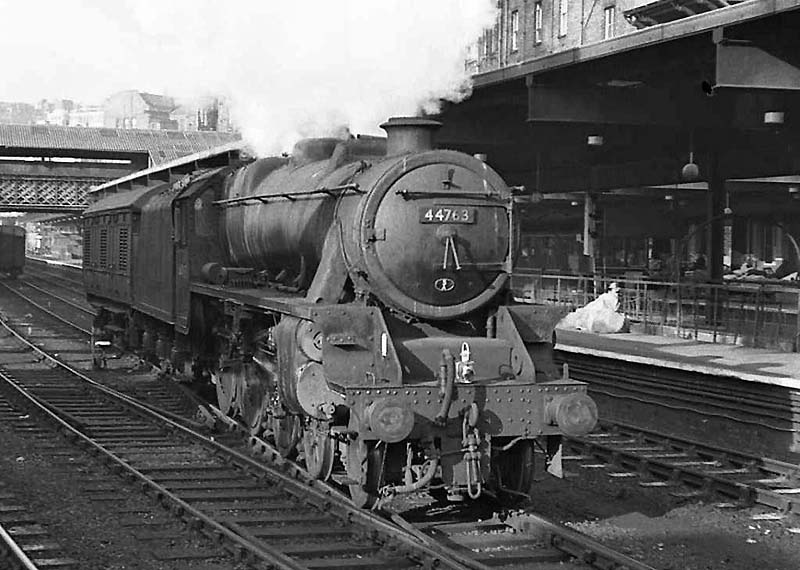 |
|
London North Western
Railway:

Midland
Railway:

Stratford
Midland Junction Railway
|

|
BR Period Locomotives: lnwrbns_br2911
 |
Another view of ex-LMS 5MT 4-6-0 No 44763 on 8th February
1964 this time with a LNWR ventilated van behind the tender. John Hyde writes
'The vehicle behind the tender is a LNWR Six Wheel Combination Truck. Built
to Diagram 444A (probably at Wolverton) over the years 1915 to 1922. (These
differed from the first vehicles, to diagram 444 built from 1910-1915, in
having hinged side doors replace the sliding doors. This gave an extra width of
six inches to their bodies.) Many examples from diagram 444A were taken into
department service in the 1950s as cell trucks and some lasted into the
1970s'. Brian Hayes of the LNWR Society corrected my supposition that the
van was being used for parcels traffic. Brian wrote 'I am reasonably
confident in suggesting the term 'parcels van' is inappropriate. I cannot
recall a combination truck being used for conveyance of parcels during my
railway career. I believe they were 'service vehicles' belonging to the CME and
conveyed supplies to the appropriate department concerned. Outdoor Machinery,
S&T and loco stores immediately come to mind.'Mike Williams, also of
the LNWR Society, writes 'Brian is correct. Its a ventilated van, not ideal
for parcels. Perishable goods, large items or wheeled vehicles making use of
the end doors are more likely. To be pedantic (and doesn't affect the caption)
in LNWR parlance its a carriage rather than a wagon - i.e. built at Wolverton
not Earlestown and in the carriage diagram book.'
Peter Ellis of the LNWR Society writes, 'More detail on
these 'Combination Trucks' than has been covered so far is known. By the time
the six wheel truck was photographed at Birmingham it would have been in use as
a stores vehicle of some kind. However in LNWR days it was generally known as a
'Combination Truck' designed for carry Fruit and/or Milk traffic. Mike Williams
is correct to state that it was carriage rather than a wagon. It would have
been built at Wolverton and was classified as part of the L&NWR's Non
Passenger Carrying Stock [NPCS] See LNWR Coaches by David Jenkinson (1978)
plates 227 and 228 for photographs of six wheeled vehicles and plate 229 for
the four-wheeled version. Two more photographs of the 4-wheeler can be found in
Talbot Miscellany I, plate 34 around 1900, and in 'Pre-Grouping Scene No 3
(1978) by O S Nock, page 77 top on which it is possible to read the lettering
'LNWR' 'Milk and Fruit Truck'. The end doors would also have enabled them to
carry early motor cars before the Company provided the D446 Covered Trucks
designed especially for this purpose. [See Jenkinson Plates 230 and 231].
Another source of information can be found in an extensive series of articles
by T W Bourne in Model Railways from June 1972 to May 1973. They must have
proved useful because many of these vehicles survived well into the 1960's and
several have been preserved. The captions on the above photographs speak of
them being built soon after 1900, but earlier versions originated before 1890
having been converted from Covered Carriage Trucks and Passenger Brake vans.
The evidence for this assertion is a summary drawing showing six designs.
Wolverton No. 4632 dated November 19th 1891'. Philip Millard, also of the
LNWR Society, added 'The former-CCT is in use as a Stores Van. This type was
extinct in revenue service at this date'.
 back back

|
